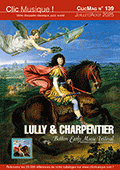|
|

Diapason de juin 2019
Critique de Michel Stockhem
Page n° 97
Classica de octobre 2019
Critique de Jérémie Cahen
Page n° 93
Format : 1 CD
Durée totale : 00:57:04
Enregistrement : 2015-2016
Lieu : Koblenz
Pays : Allemagne
Prise de son : Stereo
Label : CPO
Référence : CPO555007
EAN : 0761203500727
Code Prix : DM021A
Année d'édition : 2019
Date de sortie : 06/03/2019
Genre : Classique
|
|
 |
Aram Khachaturian (1903-1978)
Concerto pour violoncelle en mi mineur
Concerto-Rhapsodie pour violoncelle et orchestre
Torleif Thedéen, violoncelle
Staatsorchester Rheinische Philharmonie
Daniel Raiskin, direction
|
 
 Aram Khachaturian affectionnait la forme concertante. Ainsi naîtrons les trois concertos pour violon violoncelle et piano que le compositeur fera suivre bien des années plus tard par leur pendant rhapsodique. Chaque œuvre est dédiée à un soliste proche du compositeur. Le Concerto en Mi mineur pour violoncelle (1946) écrit pour Sviatoslav Knouchevitsky (du trio Oistrakh) est une page trépidante exigeant du chef et de son soliste une vigilance sans faille. Un Allegro marqué Moderato mais souvent tempétueux, extrêmement virtuose pour le soliste qui ne cesse de ferrailler avec son instrument tandis que l'orchestre lui assène des tempi impossibles. Le sombre Andante Sostenuto nous réserve heureusement de belles plages élégiaques avant que le final avec son thème dansant et sautillant nous renvoie sur le ring. La Rhapsodie pour violoncelle (1963) dédiée à Mstislav Rostropovitch en un seul mouvement illustre parfaitement la forme rhapsodique, lyrique, sans contrainte et volontiers foisonnante. Pluie de thèmes, d'atmosphères, de climats que l'imagination intarissable du compositeur nourrit à volonté. Soutenu par un chef attentif aux moindres dynamiques et nuances des partitions (Daniel Raiskin) et un orchestre armé comme une citadelle, le preux Torleif Thedéen sort indemne de cette course à l'abîme. Dans tous les cas, cette musique ne supporte pas la médiocrité. (Jérôme Angouillant)  Aram Khachaturian was an established Soviet artist when he realized an old dream of his in the first postwar year 1946 and composed a grand, quasi-symphonic work for his main instrument. Following his spectacular concertos for piano and for violin, which in the meantime had taken the world by storm, he now surprised his public with music that only gradually reveals its fiery temperament: we hear very clearly how well the composer knew the violoncello, the instrument on which during his study years he had practiced until his fingers hurt, in all its special qualities and how precisely he knew how to bring out its expressive and velvety autumnal personality. Neither this concerto nor the Rhapsody composed by Khachaturian seventeen years later for Mstislav Rostropovich can bemastered with mere virtuoso ostentation. Both works demand the services of a soloist who does not misunderstand the unprecedented difficulties of his parts as an opportunity for self-display, and Daniel Raiskin has found such an interpreter in the person of the Swedish cellist Thorleif Thedéen: sovereign in every technical respect, he surmounts the enormous challenges even when he removes himself from the intensive dialogues with the orchestra and – left entirely to his own devices – captures the whole ofKhachaturian in the monologues.
 |
| . |
 |
|
|
